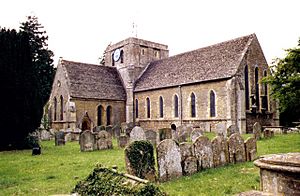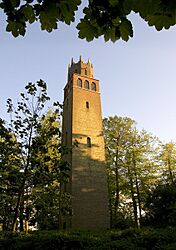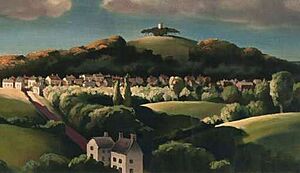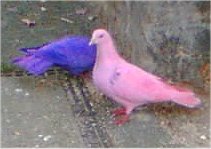Faringdon facts for kids
Quick facts for kids Faringdon |
|
|---|---|
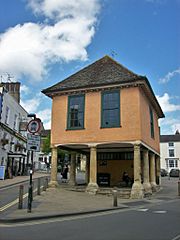 The Old Town Hall |
|
| Population | 7,121 (2011 Census) |
| OS grid reference | SU286954 |
| • London | 78 miles (126 km) |
| Civil parish |
|
| District | |
| Shire county | |
| Region | |
| Country | England |
| Sovereign state | United Kingdom |
| Post town | Faringdon |
| Postcode district | SN7 |
| Dialling code | 01367 |
| Police | Thames Valley |
| Fire | Oxfordshire |
| Ambulance | South Central |
| EU Parliament | South East England |
| UK Parliament |
|
| Website | Faringdon Town Council |
Faringdon is a historic market town in Oxfordshire, England. It is located about 18 miles (29 km) southwest of Oxford. The town offers views stretching to the River Thames in the north. To the south, you can see the highest parts of the Ridgeway.
Faringdon used to be the westernmost town in Berkshire. However, in 1974, its administration moved to Oxfordshire. This happened because of new government rules. The town's official name is Great Faringdon. This helps tell it apart from Little Faringdon nearby. In 2011, about 7,121 people lived here. Faringdon became the first place in southeast England to be named a Fairtrade Town in 2004.
Contents
History of Faringdon
What's in a Name?
The name "Faringdon" means "hill covered in fern." It's a very old name. Some people thought King Edward the Elder died here. But this isn't true.
In 1086, the Domesday Book recorded Faringdon as Farendone. It was a large settlement with 45 households. This made it one of the biggest places in England. It was owned by the king, so people didn't have to pay a special land tax.
Castles and Monks
After the Norman Conquest, a castle was built in Faringdon. The Earl of Gloucester built it. Later, King Stephen destroyed the castle. He then built a priory for Cistercian monks on the same spot. These monks were part of Beaulieu Abbey.
King John also started an abbey in Faringdon in 1202. But the monks moved to Beaulieu Abbey a year later. Faringdon became a farm area for the abbey. It helped provide food and money for the monks.
The Market Town
Faringdon was given the right to hold a weekly market in 1218. Because of this, it was sometimes called Chipping Faringdon. "Chipping" means "market." Today, a weekly outdoor market is still held every Tuesday.
In the early 1500s, King Henry VIII closed many abbeys. This was called the Dissolution of the Monasteries. The abbey lands in Faringdon were then sold to rich nobles.
Changing Borders
For many centuries, Faringdon was part of Berkshire. But as towns grew, old county borders caused problems. In 1974, a big change happened across England. Faringdon and nearby areas were moved from Berkshire to Oxfordshire. This helped make local government work better.
Places to See
All Saints' Church
The Church of England parish church of All Saints is very old. Parts of it might be from the 1100s. You can still see a Norman doorway inside. The church has a central bell tower. In 1645, during the English Civil War, the tower was hit by a cannonball. It was made shorter after that.
Today, the tower has eight bells. Some of them were made in the 1700s. The newest bells were made in 1874.
A Local Ghost Story
People say the churchyard has a ghost! It's said to be the headless ghost of a naval officer named Hampden Pye. Legend says he died in a battle explosion. His mother supposedly sent him to war to keep him away from a local girl she didn't like. The ghost was reportedly "exorcised," which means someone tried to make it leave.
Old Town Hall
The Old Town Hall is in the Market Place. It was built in the 1600s. It's a special building, listed as Grade II*. The Corn Exchange is also nearby. It was built in 1863 in a Gothic Revival style.
Faringdon Folly
East of town is Folly Hill. It has an old defensive ditch, like a hill fort. This spot was used in battles long ago. For example, Oliver Cromwell used it during the English Civil War.
The tall tower on Folly Hill is called the folly. It was designed by Lord Gerald Wellesley for Lord Berners. It was built in 1935. The folly is 140 feet (43 meters) high. From the top, you can see amazing views of the countryside. During World War II, the Home Guard used it to watch for enemies.
Some people think the folly inspired Saruman's tower, Orthanc, in J. R. R. Tolkien's The Lord of the Rings. Lord Berners even painted the folly. In 1982, it was fixed up and given to the town.
-
Faringdon Folly,
built by Lord Berners on his estate in 1935
Faringdon House
Faringdon House is a manor house and estate near the town. The first house was damaged during the English Civil War. Its owner, Sir Robert Pye, was a Royalist. His own son, Robert, who supported Parliament, attacked him there.
The current house was started around 1780. It was later home to Lord Berners in the mid-1900s.
Geology
Faringdon is known for its special rocks called Faringdon Sponge Gravel. These rocks are from the Cretaceous period. They are full of fossil sponges and other ancient sea creatures. You can also find bones and teeth from old animals.
Transport
Roads
A bypass road for Faringdon, the A420, opened in 1979. It cost £1.6 million and is about 3 miles (5 km) long.
Buses
Buses connect Faringdon to Swindon and Oxford every day. There are also bus services to nearby towns like Wantage and villages like Uffington.
Railway
A railway line, about 3.5 miles (5.6 km) long, opened in 1864. It connected Faringdon to the main Great Western Railway at Uffington. Passenger trains stopped running in 1951. Goods trains continued until 1964. The old Faringdon building is still there. It is now used as a nursery school.
Media
You can get local news and TV from BBC South and ITV Meridian. Local radio stations include BBC Radio Oxford and Heart South. The town also has local newspapers like the Herald Series.
Fun Things to Know
Faringdon is famous for the dyed pigeons at Faringdon House. An unusual person named Lord Berners started the custom of dyeing pigeons bright colors. Around town, you might see stone plaques with funny sayings. These reflect Lord Berners' playful influence.
Since 2004, Faringdon has held an annual festival. It was first called the "Faringdon Arts Festival," but now it's "FollyFest." It's a non-profit event held at the end of the school year.
Famous People from Faringdon
- Hugh Cook of Faringdon (died 1539), a monk who was the last abbot of Reading Abbey.
- William Hoare (c.1707–1792), a famous portrait painter.
- Henry James Pye (1745–1813), a poet who was the Poet Laureate of England.
- Arturo Barea (1897–1957), a Spanish journalist and writer. He lived in Faringdon for ten years.
- Mark Haskins (born 1988), a professional wrestler. He grew up in Faringdon.
- Leonard Simbarashe Rwodzi (born 1999), known as S1mba, a songwriter, singer, and rapper. He also grew up in Faringdon.
Nearby Places
 |
Lechlade | Carterton | Witney, Oxford |  |
| Highworth | Abingdon | |||
| Swindon | Fernham | Wantage |
Twin Towns
Faringdon is twinned with:
See also
 In Spanish: Faringdon para niños
In Spanish: Faringdon para niños



